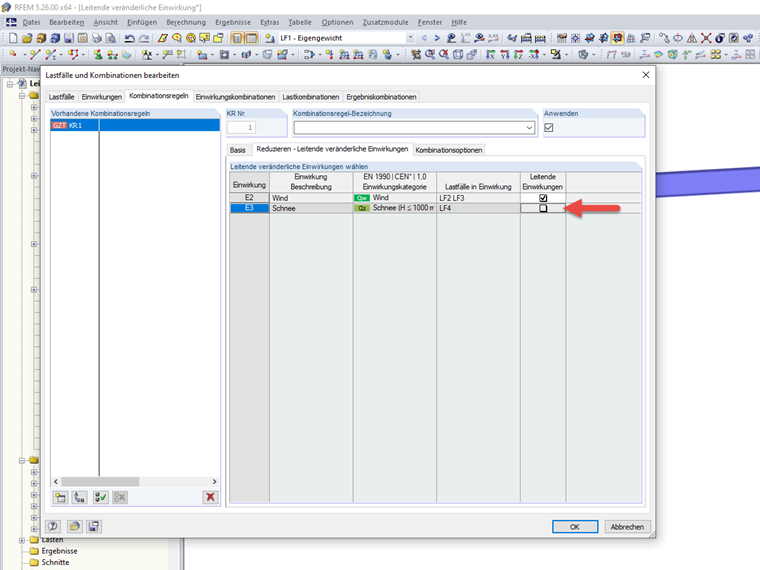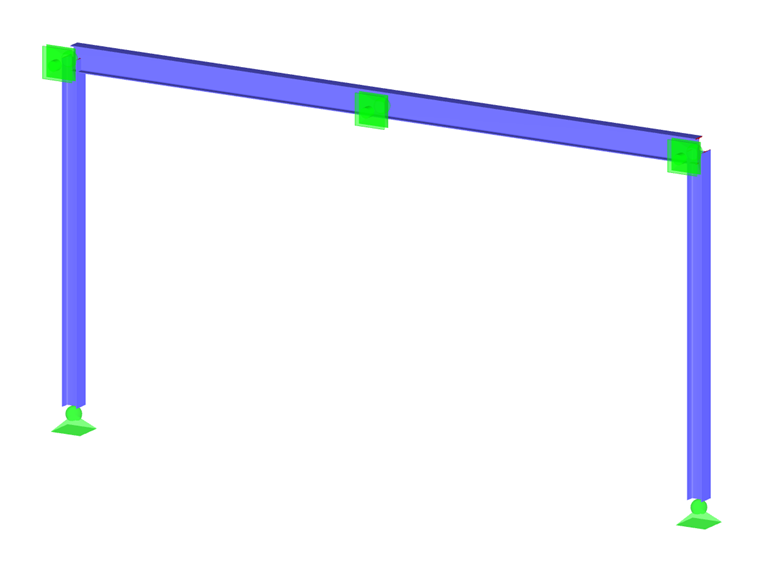The combination of actions should aim to find the most unfavorable load combination for the design for each location of the structure. To meet all safety and reality requirements, most regulations do not superimpose all actions (permanent load, wind, snow, and so on) with a hundred percent contribution, but they specify one respective leading main action and the corresponding accompanying actions. Each additional load case with a non-permanent action category increases the number of load combinations to be analyzed.
Since the calculation effort increases with the number of load combinations, efforts are always made to keep the number of load combinations low. For example, you can reduce the number of action combinations to be combined by using logical connections in order to finally reduce the number of load combinations to be analyzed.
For example, a symmetrical two-hinged frame has the following principle load cases:
| Load Case | Description | Action Category | |
|---|---|---|---|
| 1 | Self-weight | G | Permanent |
| 2 | Wind to the right | QW | Wind |
| 3 | Wind lifting | ||
| 4 | Snow | QS | Snow |
Due to the connection that the action category always acts with LC1, and the two alternating action categories (wind with LC2 and LC3, as well as snow with LC4) must each be considered as leading action and accompanying side action, the following five mathematically possible action combinations result:
EW1 = G
EW2 = G + QW
AC3 = G + QW (leading action) + QS (accompanying action)
EW4 = G + QS
AC5 = G + QW (leading action) + QS (principal action)
Splitting these action combinations results in the following eleven load combinations:
AC1 → CO1 (LC1)
AC2 → LC2 (LC1, LC2)
AC2 → LC3 (LC1, LC2, LC3)
AC2 → LC4 (LC1, LC3)
AC3 → LC5 (LC1, LC2, LC4)
AC3 → LC6 (LC1, LC2, LC3, LC4)
AC3 → CO7 (LC1, LC3, LC4)
AC4 → LC8 (LC1, LC4)
AC5 → LC9 (LC1, LC2, LC4)
AC5 → LC10 (LC1, LC2, LC3, LC4)
AC5 → LC11 (LC1, LC3, LC4)
Since every action is considered as a leading action independent of the load magnitude, there is a hidden potential to reduce the considered load cases for the combinations.
If, for example, you already know when entering the snow that the snow-covered area is very small, and this load has no governing character, you could rationalize four of the eleven load combinations by deactivating the guiding property of the snow action.
AC1 → CO1 (LC1)
AC2 → LC2 (LC1, LC2)
AC2 → LC3 (LC1, LC2, LC3)
AC2 → LC4 (LC1, LC3)
AC3 → LC5 (LC1, LC2, LC4)
AC3 → LC6 (LC1, LC2, LC3, LC4)
AC3 → CO7 (LC1, LC3, LC4)AC4 → LC8 (LC1, LC4)AC5 → LC9 (LC1, LC2, LC4)
AC5 → LC10 (LC1, LC2, LC3, LC4)
AC5 → LC11 (LC1, LC3, LC4)
In RFEM 5 and RSTAB 8, you can implement this type of reduction in the "Edit Load Cases and Combinations" menu under the "Combination Rules" tab with the "Select Leading Variable Action" option.
To do this, deactivate the meaningless actions in the "Reduce - Leading variable actions" sub-tab.
The program then takes this information into account for the automatic determination of the required combinations.



